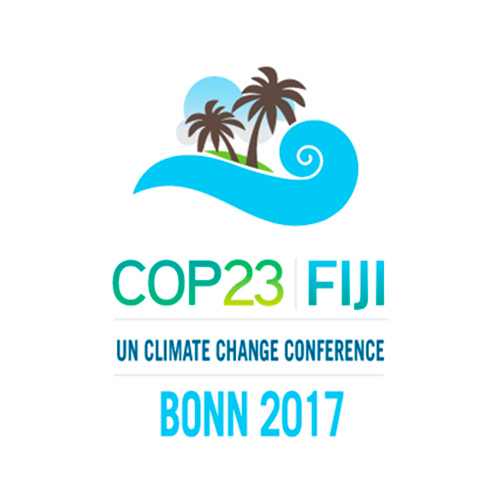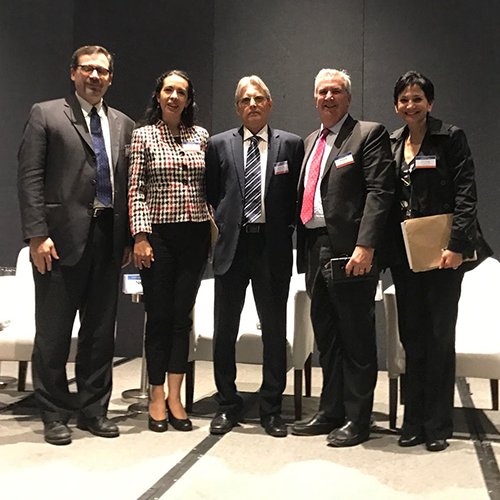 Prof. Emilio La Rovere was invited to take part of two side-events on the topics of carbon pricing and green bonds taking place as part of the Interconnections Zone during COP23 at Deutsches Institut für Entwicklungspolitik (DIE) / German Development Institute in Bonn.
Prof. Emilio La Rovere was invited to take part of two side-events on the topics of carbon pricing and green bonds taking place as part of the Interconnections Zone during COP23 at Deutsches Institut für Entwicklungspolitik (DIE) / German Development Institute in Bonn.
Find more about this events below:
When: Thursday, 16 November 2017, 10.00 am – 11.30 am
Where: Deutsches Institut für Entwicklungspolitik (DIE), Tulpenfeld 6, 53113 Bonn, Germany
The recent decade saw an unprecedented and ongoing growth in national und subnational carbon pricing initiatives around the world. The most exciting developments are currently taking place in emerging economies and developing countries in Asia and Latin America. Carbon pricing policies significantly reduce the cost of addressing climate change and unlock economic opportunities as part of the transition to a low-carbon economy. In addition, carbon pricing generates revenues which can be used to mainstream climate change into public policies to support low-carbon and climate-resilient sustainable development. This side event will bring together academics, policymakers and stakeholders to discuss prospects and challenges for carbon pricing in the context of the Paris Agreement and Agenda 2030.
Speakers:
- Constanze Haug, International Carbon Action Partnership
- Ottmar Edenhofer, Mercator Research Institute on Global Commons and Climate Change
- Oskar Lecuyer, Agence Française de Développement
- Sébastien Postic, Institute for Climate Economics
- Duan Maosheng, Tsinghua University
- John Roome, World Bank
When: Friday, 17 November 2017, 10.00-12.00 a.m.
Where: Deutsches Institut für Entwicklungspolitik (DIE), Tulpenfeld 6, 53113 Bonn, Germany
For achieving a 2°C compatible pathway an enormous investment gap exists which has to be financed both with public and private funds. A promising innovative financial instrument for achieving this goal are green bonds. While the green bond market has expanded sizably worldwide, several barriers to its further development exist including the lack of harmonised standards across countries and types of bonds. The aim of this side event is to discuss the main barriers for emerging economies to the further development of the green bond market and to elaborate policy recommendations among experts from the civil society, public and private sector as well as academics.
Speakers:
- Brian Gillard, German Stock Exchange AG
- Torsten Ehlers, Bank for International Settlements
- Aldo M. Romani, European Investment Bank
- Manuel Adamini, Climate Bonds Initiative
- Alba Aguilar Priego, MEXICO2, Company of the Mexican Stock Exchange
- Kathrin Berensmann, German Development Institute
 Date: on November, 14 2017 at 1.15pm to 2.45pm
Date: on November, 14 2017 at 1.15pm to 2.45pm
Local: at EU Pavilion, in Bonn, Germany.
Title of presentation: Carbon revenues: bridging the gap from climate issues to fiscal benefits
Co-organizers: World Bank, AFD, I4CE, Ecofys, the Generation Foundation
Thematic focus: carbon pricing, fiscal policies, NDC
Moderator: James CLOSE, Senior director climate change, World Bank
Speakers:
1. Emilie ALBEROLA, Program Director Industry and Energy, Institute for Climate Economics (I4CE)
2. Ian TRIM, Associate Director, Ecofys
3. One representative from a covered entity - TBC
4. Emilio Lebre la Rovere, Executive Coordinator of the Center for Integrated Studies on Climate Change and the Environment, Federal University of Rio, Brazil
Description: An increasing number of countries are exploring how carbon-pricing instruments could help them meet their NDC goals. This event will look at how to use revenues generated by carbon pricing policies to support a low-carbon and climate-resilient development, from the perspective of policy makers in developing countries (World Bank Group-WBG, the Agence Française de Development-AFD and the Institute for Climate Economics-I4CE) as well as of entities covered by carbon pricing instruments (Ecofys and the Generation Foundation under their Carbon Pricing Unlocked partnership).
Other info: This event will present some early results of the WBG-AFD-I4CE study and will launch the new publication of the CPU partnership. Panelists (researchers as well as practitioners from the public and private sector) will discuss some of the challenges and opportunities associated with their experience of the use of carbon revenues.
 Launched in November 2016 at the COP22 in Morocco, at the invitation of the two Co-Chairs of the Carbon Pricing Leadership Coalition (CPLC) High Level Assembly, Ségolène Royal (Minister of Environment, France) and Feike Sijbesma, the High-Level Commission on Carbon Prices, led by the two famous economists Joseph Stiglitz, and Lord Nicholas Stern, gathered 11 economists, climate change and energy specialists from all over the world, to help spur successful implementation of the Paris Agreement. The commissioners have delivered its report at the end of May, 2017.
Launched in November 2016 at the COP22 in Morocco, at the invitation of the two Co-Chairs of the Carbon Pricing Leadership Coalition (CPLC) High Level Assembly, Ségolène Royal (Minister of Environment, France) and Feike Sijbesma, the High-Level Commission on Carbon Prices, led by the two famous economists Joseph Stiglitz, and Lord Nicholas Stern, gathered 11 economists, climate change and energy specialists from all over the world, to help spur successful implementation of the Paris Agreement. The commissioners have delivered its report at the end of May, 2017.
The Commission’s objective was to identify indicative corridors of carbon prices which can be used to guide the design of carbon pricing instruments and other climate policies, regulations, and measures to incentivize bold climate action and stimulate learning and innovation to deliver on the ambition of the Paris Agreement and support the achievement of the Sustainable Development Goals.
1. Carbon pricing is an indispensable part of a strategy for reducing emissions in an efficient way.
2. Pricing carbon is not enough, and a carbon price works best in a supportive environment
3. Climate policies and carbon pricing need to be designed so that they support economic growth, development, innovation, and poverty reduction.
“Meeting the world’s agreed climate goals in the most cost-effective way while fostering growth requires countries to set a strong carbon price, with the goal of reaching $40-$80 per tonne of CO2 by 2020 and $50-100 per tonne by 2030.”
These price ranges assume that the pricing policy is complemented with well-designed policies and actions—such as efficiency standards, research and development, city design, networks, etc.—and a supportive investment climate, including finance. In the absence of these elements, the carbon-price range required is likely to be higher.
Appropriate carbon prices will vary across countries, and low-income countries may start with prices lower than this range.
Carbon prices will need to be adjusted over time, particularly upward if existing prices fail to bring about the required changes, but based on criteria that are transparent and sound.
Implementation of carbon pricing should take into account non-climate benefits, particularly reduced pollution, local context, and political economy.
Further information here
Photo of the first meeting of the Stiglitz – Stern Commission on January 31st, 2017, in Paris.
In the first line, left to right, are Emilio La Rovere, Lord Nicholas Stern, Minister Ségolène Royal, and Nobel Prize Joseph E. Stiglitz.

Find more about all members here
 On October 18, Prof. Emilio La Rovere made a presentation and discussed topics about carbon pricing in the Plenary 2: “What role for carbon pricing for delivering on the Paris Agreement?” at The Latin American and Caribbean Carbon Forum (LACCF).
On October 18, Prof. Emilio La Rovere made a presentation and discussed topics about carbon pricing in the Plenary 2: “What role for carbon pricing for delivering on the Paris Agreement?” at The Latin American and Caribbean Carbon Forum (LACCF).
This is the abstract of Prof. La Rovere’s presentation:
Smart financial mechanisms can help to foster investment in low-carbon infrastructure with a lower explicit carbon price, alleviating the negative impacts of carbon taxes on economic activity and social gains. Reducing the risk of low carbon investments by lowering their capital costs can be obtained through public guarantees allocated in proportion to the project’s expected reduction in GHGs emissions for agreed upon values per ton. These values should reflect, as required by the paragraph 108 of the COP21 ‘Decision’ of the Paris Agreement, ‘the social, economic, and environmental value of mitigation actions and their co-benefits to adaptation, health, sustainable development” (SVMA). An innovative financial device anchored in the SVMA can help to channel international funds to increase public guarantees and reduce the risk of low carbon investments in the LAC region, allowing for a reduction in capital costs of these projects.
Topic: What Role for Carbon Pricing for Delivering on the Paris Agreement?
On October 18, at 11:30 - 13:00
J. Stiglitz and N. Stern indicate in the recently-launched Report of the High-Level Commission on Carbon Prices that a well-designed and robust carbon pricing strategy is an indispensable component of overall policy to efficiently reduce GHG emissions without penalizing economic growth. To date, only 15% of global emissions are covered by a carbon pricing instrument. This high-level discussion aimed to explore tailored ways to expand coverage and impact of carbon pricing instruments in LAC region, and identify opportunities for growth and revenue generation offered by carbon pricing.
Moderator: Beatriz Bugeda (Regional Manager, Mexico & Latin America - The Climate Reality Project)
• Enrique Lendo (Head of International Affairs - SEMARNAT, Mexico)
• Steve Hammer (Manager, Climate Analytics and Advisory Services, Climate -Change Group, World Bank)
• Emilio Lèbre La Rovere (Executive Coordinator, Center for Integrated Studies on Climate Change, Federal University of Rio de Janeiro, Brazil)
• Dirk Forrister (President & CEO, IETA)

Check the Programm Guide out here
Further information: http://latincarbon.com/
 Apresentação oral da aluna Isabella Zicarelli
Apresentação oral da aluna Isabella ZicarelliData: 24/10/17
Horário: 14:30 às 17:30 (terça-feira)
Local: CT Bloco: A Andar: 2º Sala 201 - I
Título da apresentação oral: Emissões de gases de efeito estufa (GEE) do setor energético do estado do Rio de Janeiro inventário, cenários e medidas de mitigação utilizando a ferramenta de modelagem leap
Orientador: Prof. Emilio Lèbre La Rovere
Data: 25/10/17 (quarta-feira)
Horário: 14:30 às 17:30
Local: CT Bloco: B Andar: 2º Hall do Bloco B - II
Título do pôster: Análise das políticas de mitigação de emissões de gases de efeito estufa do setor de agricultura no estado do rio de janeiro e simulação de cenários de mitigação
Orientador: Prof. Emilio Lèbre La Rovere
